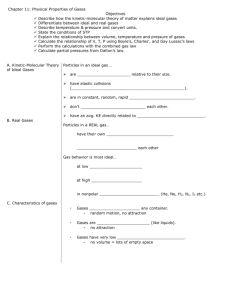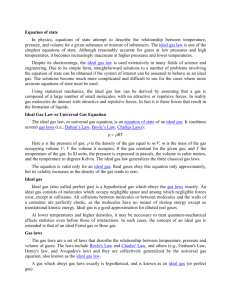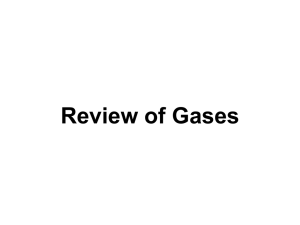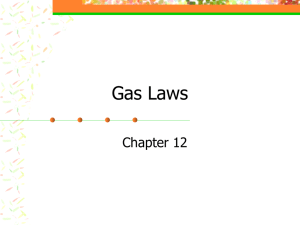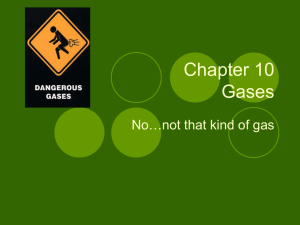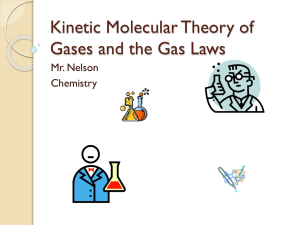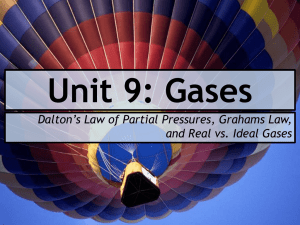Sec. 12.1
advertisement
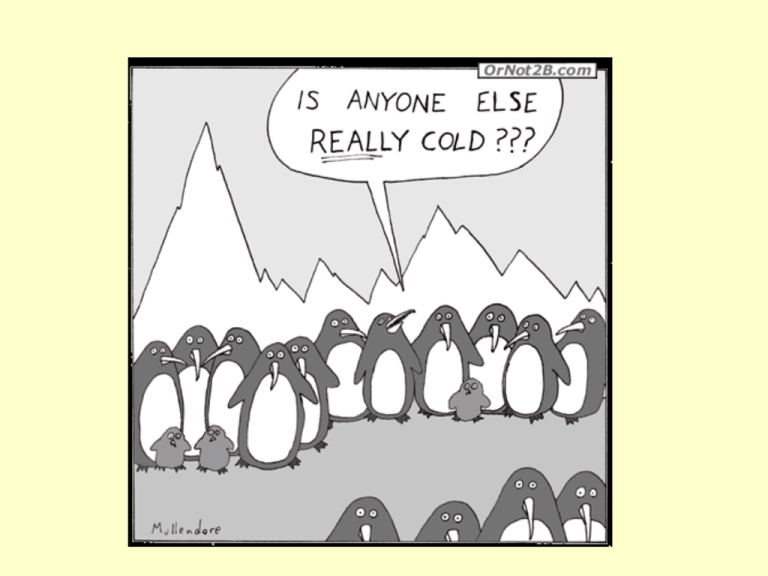
Friday, Jan. 10th: “A” Day Monday, Jan. 13th: “B” Day Agenda Begin Chapter 12: “Gases” 12.1: “Characteristics of Gases” Pressure, newton, pascal, STP, kinetic-molecular theory Pressure Demos In-Class/Homework: Pg. 422: #1-12 Concept Review: “Characteristics of Gases” Quiz over this section next time! Gases Chapter #12 Gases are Unique Gases have unique properties because the distance between the particles is much greater than in a liquid or a solid. Properties of Gases 1. Gases are Fluids – Gases are considered fluids because they have the ability to FLOW. 2. Gases Have Low Density – Because of the large distances between gas molecules, most of the volume occupied by a gas is empty space. 3. Gases are Highly Compressible – Applying a small pressure will move the gas particles closer together and will decrease the volume. 4. Gases Completely Fill a Container – A gas expands to fill the entire volume available. Pressure Demos Plastic Bag in Beaker Straw Through Potato The Can Crusher Egg in a Bottle Vacuum Pack People (we’ll wait until the end to do this one!) Air pressure is caused by collisions of gas molecules. Measuring Pressure Pressure: the amount of force exerted per unit area of surface (force/area) Newton (N): the SI unit of force The force that gives an acceleration of 1 m/s2 to an object whose mass is 1 kg. 1 N = 1 kg∙1 m/s2 Pascal (Pa): the SI unit of pressure The force of 1 N exerted over an area of 1 m2 1 Pa = 1 N/m2 A Mercury Barometer Measures Atmospheric Pressure Atmospheric Pressure At sea level, the atmosphere keeps the mercury (Hg) in a barometer at 760 mm, which is 1 atmosphere. 1 mm of Hg is also called a torr, named after Italian physicist Evangelista Torricelli, who invented the barometer. (Handsome devil, isn’t he?) Equivalent Pressure Units In this chart, your book uses spaces instead of commas… Standard Temperature & Pressure (STP) To study the effects of changing temperature and pressure on gases, scientists have specified a set of standard conditions called standard temperature and pressure, or STP. STP = O˚C and 1 atm Sample Problem A, Pg. 420 Converting Pressure Units Convert the pressure of 1.000 atm to millimeters of mercury. 1.000 atm X 101,325 Pa = 101,325 Pa 1 atm 101,325 Pa X 1 mm Hg = 133.322 Pa 760.0 mm Hg (4 sig figs) Additional Practice The vapor pressure of water at 50.00˚C is 12.33 kPa. What is this value in millimeters of mercury? 12.33 kPa X 1,000 Pa = 12,330 Pa 1 kPa 12,330 Pa X 1 mm Hg = 133.322 Pa 92.48 mm Hg (4 sig figs) The Kinetic-Molecular Theory Kinetic-molecular theory: a theory that explains that the behavior of physical systems depends on the combined actions of the molecules constituting the system. In Plain English: the kinetic-molecular theory is a model that is used to predict gas behavior. The Kinetic-Molecular Theory 1. Gas particles are in constant rapid, random motion. 2. Gas particles are very far apart relative to their size. 3. The pressure exerted by a gas is a result of the collisions of the molecules against the walls of the container. 4. The collisions are considered elastic (energy is completely transferred during collisions). Gas Temperature is Proportional to Average Kinetic Energy Gas Temperature is Proportional to Average Kinetic Energy For a 10˚C rise in temperature from STP, the average energy increases about 3%, while the number of very high-energy molecules about doubles or triples. In-Class/Homework Section 12.1 review: Pg. 422, #1-12 Concept Review: “Characteristics of Gases” Be ready for a quiz next time over this section!


